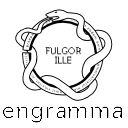Mnemosyne Atlas 37
Irruzione dell'antico: temperamento dionisiaco e scultura dipinta
Il disegno archeologico e la scultura in dipinto (grisaille e monumento equestre) come espedienti per l’irruzione del pathos dionisiaco (lotta, ratto) nell’arte del primo Rinascimento (Pisanello, Pollaiolo). Il temperamento patetico emerge nella pittura mitologica all’antica (Ercole), e non nelle scene 'alla franzese', pur tematicamente affini.
Irruption of Antiquity: Dionysiac temperament and sculpture in painting
Archaeological drawings and painted sculpture (such as grisaille reliefs and equestrian monuments represented in frescoes) used as expedients for the irruption of Dionysiac pathos (fight, rape) in early Renaissance art (Pisanello, Pollaiolo). Emotional temperament emerges in ‘all’antica’ mythological paintings (Hercules) rather than in scenes 'alla franzese', despite featuring similar subjects.
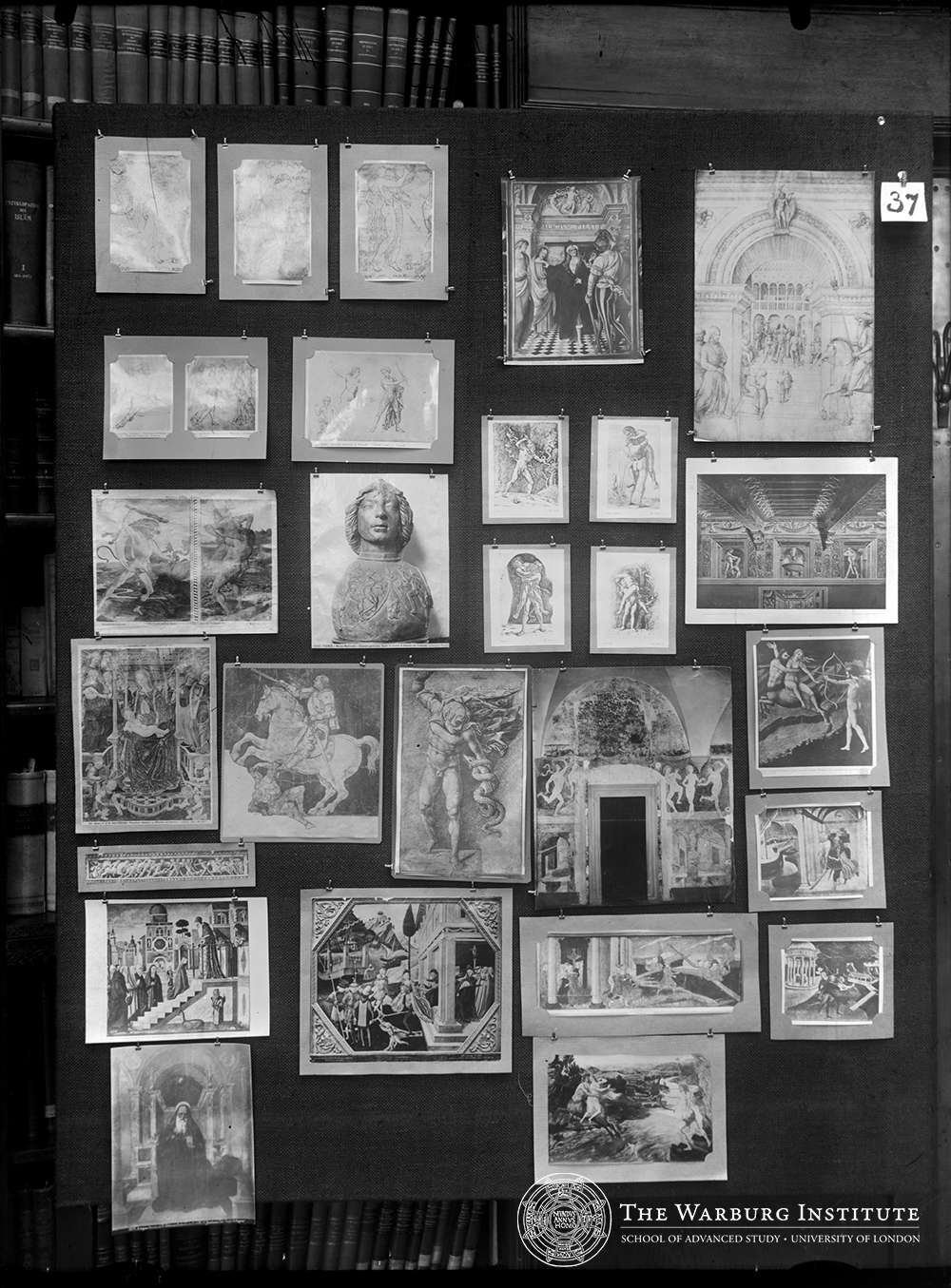
Appunti di Aby Warburg (1929)
Pollajuolo
Pollaiolo.
Appunti di Aby Warburg e collaboratori (1929)
Eindringen der Antike als Plastik. Archäologische Zeichnung (Giusto da Padova, Pisanello). Grisaille = Gemalte Plastik. Reiterstandbild. Schlangenmann (Zeichnung) Herkuleskämpfe (Pollaiuolo): Stich, Rüstung [Relief] statuarisches Gemälde. Hercules u. Nessus = Freiwerden des Temperaments im Zusammenhang m. anderen Raubszenen. Tänzerfries des Pollaiuolo.
Irruzione dell'antico come scultura. Disegno archeologico (Giusto da Padova, Pisanello). Grisaille = scultura dipinta. Statua equestre. L’uomo dei serpenti (disegno) Combattimenti di Ercole (Pollaiolo): Incisione, armatura (rilievo), dipinto scultoreo. Ercole e Nesso = sprigionarsi del temperamento in connessione con altre scene di ratto. Fregio dei danzatori di Pollaiolo.
Appunti di Gertrud Bing (1940 ca)
Befreiung des Körpers vom Kleiderzwang. Bewegung wird durch den nackter Körpers ausdrückbar. Wie wir trotzdem die heidnische Wildheit gebändigt? Giusto da Padua geist, daß diesen Prozess sich an der Antike vollspielt “Colla Firenze degli anteriori”. An welcher Gegenständen wird es gestattet? 1) Hercules als Prototyp der Kraft a) Schlange? b) Anthëus(“antikische Bewegung” = zurück zum Ursprung) c) Raub und Vergeltung. Die moralische Interpretation. Gleichnis Charakter gewahrt durch Verwendung unter der Decke und auf dem Harnisch. d.h. Autorisation kommt vom Bildinhalten. 2) Autorisation durch Aussonderung aus dem Bildinhalt = Grisaille a) Tanzende Putten – physischer Überschwang zwar am Thron der Madonna, aber als Fries, ebenso die tanzenden Männer in Arcetri (Vergleich mit d. Teppichbehängen) b) Grisaille: Kreuzigung Herkules; Pilatus. Laokoon c) Plastiken der Heidengötter als Zeichen ihrer Überwindung: Maria Tempelgang, Kommunion der Hl. Hieronymus (NB Hl. Hieronymus Tritt., wie Hercules, Perseus, Konstantin, Paris in verschiedenen Funktionen auf, nämlich Gehäus = Kontemplation, Kommunion = Einverleibung). Helena-Raub nur nicht ganz klar. Nur unter d. Schlagwort “Bewegung”? Kein. Beispiel d. nackte Körper! Parallele zum Nessus-Raub? Scheint mit nicht unmöglich.
Liberazione del corpo dalla costrizione dell’abito. Il movimento diventa esprimibile attraverso il corpo nudo. Tuttavia, come si fa a domare la sfrenatezza pagana? Giusto da Padova sostiene che questo processo si gioca tutto sull’antichità “Colla Firenze degli anteriori”. Su quali soggetti è consentito? 1) Ercole come prototipo della forza a) Serpente? b) Anteo (“movimento all’antica” = ritorno alle origini) c) Ratto e punizione. L’interpretazione moralizzata. Carattere di parabola preservato [dal travestimento] sotto il mantello e sulla corazza; il ricorso è determinato vale a dire il permesso scaturisce dal contenuto della rappresentazione 2) Uso consentito attraverso la presa di distanza dal contenuto dell’immagine = grisaille a) Putti danzanti, esuberanza fisica sul trono della Madonna, ma come fregio, così come per i danzatori di Arcetri (confronto con gli arazzi) b) Grisaille: crocifissione, Ercole, Pilato, Laocoonte c) Sculture degli dèi pagani come simbolo del loro superamento: presentazione di Maria al tempio, comunione di San Girolamo (N.B. Trittico di San Girolamo come Ercole, Perseo, Costantino, Paride in funzioni diverse, cioè cella = contemplazione = comunione = incarnazione). Solo il ratto di Elena non mi è del tutto chiaro. Solo sotto la voce “movimento”? No. Esempio di corpo nudo! Parallelo con il ratto di Nesso? Non mi sembra impossibile.
Letture di approfondimento
Notes by Aby Warburg (1929)
Pollajuolo
Antonio del Pollaiuolo.
Notes by Aby Warburg and coll. (1929)
Eindringen der Antike als Plastik. Archäologische Zeichnung (Giusto da Padova, Pisanello). Grisaille = Gemalte Plastik. Reiterstandbild. Schlangenmann (Zeichnung) Herkuleskämpfe (Pollaiuolo): Stich, Rüstung [Relief] statuarisches Gemälde. Hercules u. Nessus = Freiwerden des Temperaments im Zusammenhang m. anderen Raubszenen. Tänzerfries des Pollaiuolo.
The intrusion of Antiquity in the form of sculpture. Archaeological drawing (Giusto da Padova, Pisanello). Grisaille = painted sculpture. Equestrian statue. Serpent man (drawing). The combats of Hercules (Pollaiuolo): engraving, armour [relief], the statue as painting. Hercules and Nessus = setting free of the temperament in connection with other scenes of rape. Pollaiuolo’s frieze of dancers.
Notes by Gertrud Bing (ca. 1940)
Befreiung des Körpers vom Kleiderzwang. Bewegung wird durch den nackter Körpers ausdrückbar. Wie wir trotzdem die heidnische Wildheit gebändigt? Giusto da Padua geist, daß diesen Prozess sich an der Antike vollspielt “Colla Firenze degli anteriori”. An welcher Gegenständen wird es gestattet? 1) Hercules als Prototyp der Kraft a) Schlange? b) Anthëus(“antikische Bewegung” = zurück zum Ursprung) c) Raub und Vergeltung. Die moralische Interpretation. Gleichnis Charakter gewahrt durch Verwendung unter der Decke und auf dem Harnisch. d.h. Autorisation kommt vom Bildinhalten. 2) Autorisation durch Aussonderung aus dem Bildinhalt = Grisaille a) Tanzende Putten – physischer Überschwang zwar am Thron der Madonna, aber als Fries, ebenso die tanzenden Männer in Arcetri (Vergleich mit d. Teppichbehängen) b) Grisaille: Kreuzigung Herkules; Pilatus. Laokoon c) Plastiken der Heidengötter als Zeichen ihrer Überwindung: Maria Tempelgang, Kommunion der Hl. Hieronymus (NB Hl. Hieronymus Tritt., wie Hercules, Perseus, Konstantin, Paris in verschiedenen Funktionen auf, nämlich Gehäus = Kontemplation, Kommunion = Einverleibung). Helena-Raub nur nicht ganz klar. Nur unter d. Schlagwort “Bewegung”? Kein. Beispiel d. nackte Körper! Parallele zum Nessus-Raub? Scheint mit nicht unmöglich.
Liberation of the body from the constraint of clothing. Movement becomes expressible through the naked body. However, how does one tame pagan wildness? Giusto da Padova argues that this process is all about antiquity “Colla Firenze degli anteriori”. On which subjects is this allowed? 1) Hercules as the prototype of strength a) Serpent? b) Antaeus (‘movement all’antica' = return to the origins) c) Rape and punishment. Moralised interpretation. Allegorical character preserved by use, under cover and on the armour. i.e. authorisation comes from the content of the image. 2) Use permitted through distancing from the content of the image = grisaille a) Dancing putti, physical exuberance on the Madonna’s throne, but as frieze, as for the dancers in Arcetri (comparison with tapestries) b) Grisaille: crucifixion, Hercules, Pilate, Laocoon c) Sculptures of pagan gods as symbols of the conquest over them: presentation of Mary in the temple, communion of St Jerome (N.B. Triptych of St Jerome as Hercules, Perseus, Constantine, Paris in different functions, i.e. cell = contemplation = communion = incarnation). Only the abduction of Helen is not entirely clear to me. Only under the keyword “movement”? No. Example of a naked body! Parallel with the Rape of Nessus? Doesn’t seem impossible to me.
Further Readings

1. Trionfo di Dioniso, disegno tardo medioevali da un sarcofago neoattico da Ercolano, 30-40 d.C., Napoli, Museo Nazionale.
2. Satiri, disegno tardo medioevali da un sarcofago neoattico da Ercolano, 30-40 d.C., Napoli, Museo Nazionale.
3. Menadi, disegno tardo medioevali da un sarcofago neoattico da Ercolano, 30-40 d.C., Napoli, Museo Nazionale.
4. Gaudenzio Ferrari, Cristo nel palazzo di Pilato, affresco, 1507-1513, Varallo, S. Maria delle Grazie.
5. Jacopo Bellini, Flagellazione di Cristo, disegno a penna dall'Album di schizzi parigino, 1430-1450, fol. 8r, Paris, Musée du Louvre.
6. Pisanello (attribuzione), Centauro galoppante, disegno da sarcofago antico, 1440 ca., Paris, Musée du Louvre, Département des Artes Graphiques.
7. Pisanello, Menadi, disegno da un bassorilievo antico su sarcofago bacchico, Oxford, University Museum.
8. Pisanello (o Gentile da Fabriano), copie da pezzi antichi: figura femminile in fuga; figura inginocchiata; figura maschile che brandisce un'arma; disegno a penna, Paris, Musée du Louvre, Département des Artes Graphiques.
9. Andrea Mantegna (?), Ercole e l'Idra, acquaforte su rame, 1500 ca., London, The British Museum.
10. Andrea Mantegna, Ercole e Anteo, acquaforte su rame, 1500 ca.
11. Antonio Pollaiuolo, Ercole e l'Idra, olio su tavola, 1460-1470, Firenze, Galleria degli Uffizi.
12. Antonio Pollaiuolo, Ercole e Anteo, olio su tavola, 1460-1470, Firenze, Galleria degli Uffizi.
13. Antonio Pollaiuolo, Giovane guerriero con "fatiche di Ercole" sulla corazza, imitazione del bronzo in terracotta dipinta, 1475-1480 ca., Firenze, Museo Nazionale del Bargello.
14. Scuola di Mantegna, Ercole e Anteo, acquaforte su rame, 1510 ca.
15. Giovanni Antonio da Brescia (da Mantegna), Ercole e Anteo, acquaforte su rame, 1497 ca.
16. Antonio Pollaiuolo, Le fatiche di Ercole, affresco, seconda metà del sec. XV, Roma, Palazzo Venezia.
17. Giovanni Boccati, Madonna e angeli, seconda metà del sec. XV, Perugia, Galleria Nazionale dell'Umbria.
18. Antonio Pollaiuolo, Studio per un monumento equestre di Francesco Sforza, disegno a penna sfumato, 1485 ca., München, Staatliche Graphische Sammlungen.
19. Andrea Mantegna, Fauno in lotta con un serpente, disegno a penna, 1480-1485, London, The British Museum, Department of Prints and Drawings.
20. Antonio Pollaiuolo, Danzatori nudi, affresco, 1465-1475, Firenze, Villa Gallina.
21. Jacopo Bellini (o Pisanello), Ratto di Deianira, dipinto, 1460 ca., London, Agnew Collection.
21a. Cosiddetto "Maestro del giudizio di Paride", Ratto di Elena, cassone, 1450-70, Praha, Rudolfinum.
22. Giovanni Boccati, Scena di battaglia (particolare), da Madonna e angeli, seconda metà del sec. XV, Perugia, Galleria Nazionale dell'Umbria.
23. Vittore Carpaccio, La presentazione della Vergine al tempio, 1505-1506, Milano, Pinacoteca di Brera.
24. Scuola di Fra' Angelico (Benozzo Gozzoli?), Ratto di Elena, seconda metà del sec. XV, London, National Gallery.
25. Lorenzo Costa, San Gerolamo, dipinto su tavola, 1485 ca., Bologna, San Petronio, Cappella de' Castelli.
26. Liberale da Verona (attribuzione), Ratto di Elena, cassone, 1470 ca., Avignone, Musée du Petit Palais.
27. Antonio Pollaiuolo, Ratto di Deianira, tempera e olio su tela (riportato da una tavola), 1460-1480, New Haven (Conn.), Yale University Art Gallery.
28. Cosiddetto "Maestro del giudizio di Paride", Ratto di Elena, cassone, 1450-1470, Wien, Sammlung Lanckoronski.
1. Triumph of Dionisyus, drawing late Medieval of a neo-attic sarcophagus from Ercolano, 30-40 d.C., Napoli, Museo Nazionale.
2. Satyrs, drawing late Medieval of a neo-attic sarcophagus from Ercolano, 30-40 d.C., Napoli, Museo Nazionale.
3. Maenads, drawing late Medieval of a neo-attic sarcophagus from Ercolano, 30-40 d.C., Napoli, Museo Nazionale.
4. Gaudenzio Ferrari, Christ in Pilato’s palace, fresco, 1507-1513, Varallo, S. Maria delle Grazie.
5. Jacopo Bellini, Flagellation of Christ, ink drawing from the Parisian sketchbook, 1430-1450, fol. 8r, Paris, Musée du Louvre.
6. Pisanello (awarding), galloping Centaur, drawing of antique sarcophagus, 1440 ca., Paris, Musée du Louvre, Département des Artes Graphiques.
7. Pisanello, Maenads, drawing of antique bas relief on Bacchic sarcophagus, Oxford, University Museum.
8. Pisanello (or Gentile da Fabriano), copies from antique pieces: female figure on the run ; kneeling figure; male figure wielding a weapon; ink drawing, Paris, Musée du Louvre, Département des Artes Graphiques.
9. Andrea Mantegna (?), Hercules and the Idra, echting on copper, 1500 ca., London, The British Museum.
10. Andrea Mantegna, Hercules and Anteos, echting on copper, 1500 ca.
11. Antonio Pollaiuolo, Hercules and the Idra, oil on canvas, 1460-1470, Firenze, Galleria degli Uffizi.
12. Antonio Pollaiuolo, Hercules and Anteos, oil on canvas, 1460-1470, Firenze, Galleria degli Uffizi.
13. Antonio Pollaiuolo, Young warrior with “The labors of Hercules” on the armor, imitation of the copper in depicted terracotta 1475-1480 ca., Firenze, Museo Nazionale del Bargello.
14. Scuola di Mantegna, Hercules and Anteos, echting on copper, 1510 ca.
15. Giovanni Antonio da Brescia (da Mantegna), Hercules and Anteos, echting on copper, 1497 ca.
16. Antonio Pollaiuolo, The labors of Hercules, fresco, second half of 15th Century, Roma, Palazzo Venezia.
17. Giovanni Boccati, Holy Mother and Angels, second half of 15th Century, Perugia, Galleria Nazionale dell'Umbria.
18. Antonio Pollaiuolo, Study for an equestrian monument of Francis Sforza, sfumato ink drawing, 1485 ca., Munich, Staatliche Graphische Sammlungen.
19. Andrea Mantegna, Faun in struggle with a snake, ink drawing, 1480-1485, London, The British Museum, Department of Prints and Drawings.
20. Antonio Pollaiuolo, Naked Dancers, fresco, 1465-1475, Firenze, Villa Gallina.
21. Jacopo Bellini (o Pisanello), Deianira’s rape, painting, 1460 ca., London, Agnew Collection.
21a. So-called "Teacher of the judgment of Paride", Helen’s rape, chest, 1450-1470e, 1450-70, Praha, Rudolfinum.
22. Giovanni Boccati, Scene battle (detail), from Holy Mother and Angels, second half of 15th Century, Perugia, Galleria Nazionale dell'Umbria.
23. Vittore Carpaccio, The presentation of the Virgin to the temple, 1505-1506, Milano, Pinacoteca di Brera.
24. School of Fra' Angelico (Benozzo Gozzoli?), Helen’s rape, second half of 15th Century, London, National Gallery.
25. Lorenzo Costa, San Gerolamo, painted on table, 1485 ca., Bologna, San Petronio, Cappella de' Castelli.
26. Liberale da Verona (attribution), Helen’s rape, chest, 1470 ca., Avignon, Musée du Petit Palais.
27. Antonio Pollaiuolo, Deianira’s rape, temper and oil on canvas (brought by a table), 1460-1480, New Haven (Conn.), Yale University Art Gallery.
28. So-called "Teacher of the judgment of Paride", Helen’s rape, chest, 1450-1470, Wien, Sammlung Lanckoronski.

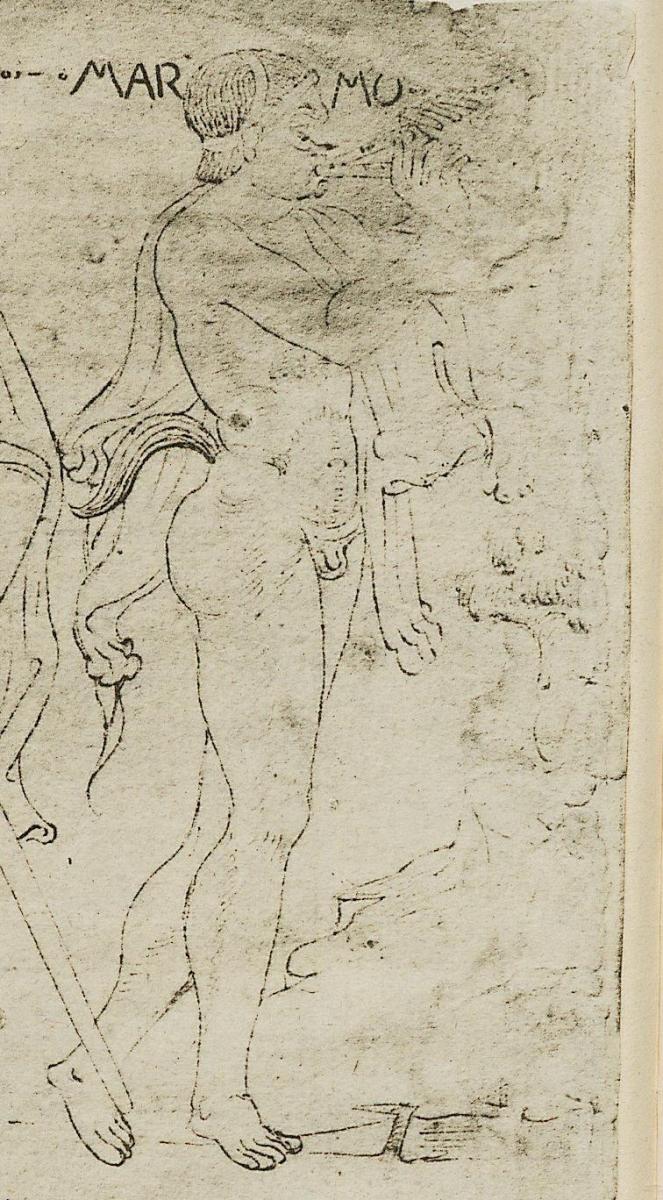
1. Trionfo di Dioniso, disegno tardo medioevale da un sarcofago neoattico da Ercolano, 30-40 d.C., Napoli, Museo Nazionale
1. Triumph of Dionisyus, drawing late Medieval of a neo-attic sarcophagus from Ercolano, 30-40 d.C., Napoli, Museo Nazionale
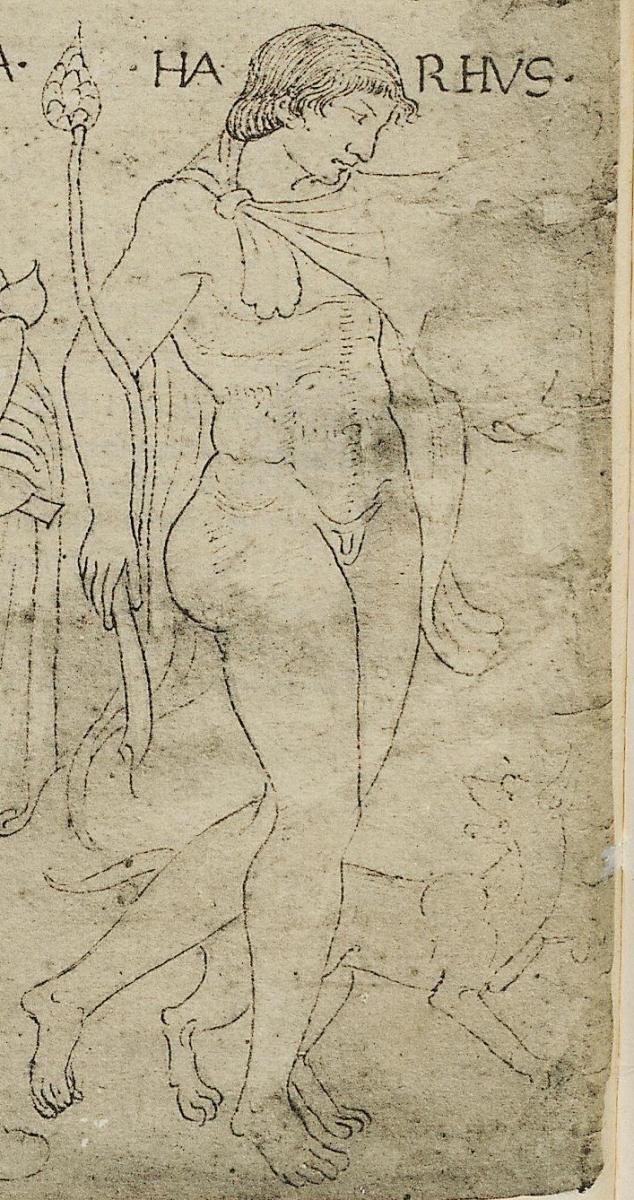
2. Satiri, disegno tardo medioevali da un sarcofago neoattico da Ercolano, 30-40 d.C., Napoli, Museo Nazionale
2. Satyrs, drawing late Medieval of a neo-attic sarcophagus from Ercolano, 30-40 d.C., Napoli, Museo Nazionale
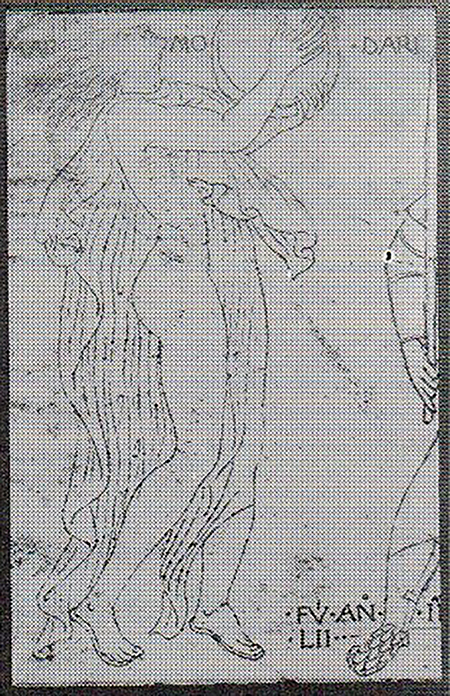
3. Menadi, disegno tardo medioevali da un sarcofago neoattico da Ercolano, 30-40 d.C., Napoli, Museo Nazionale
3. Maenads, drawing late Medieval of a neo-attic sarcophagus from Ercolano, 30-40 d.C., Napoli, Museo Nazionale
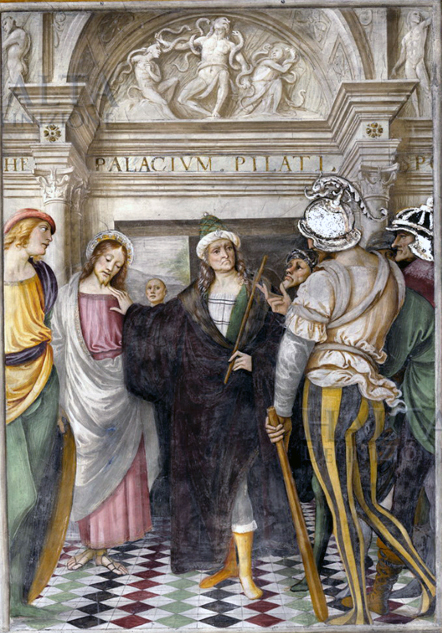
4. Gaudenzio Ferrari, Cristo nel palazzo di Pilato, affresco, 1507-1513, Varallo, S. Maria delle Grazie
4. Gaudenzio Ferrari, Christ in Pilato’s palace, fresco, 1507-1513, Varallo, S. Maria delle Grazie
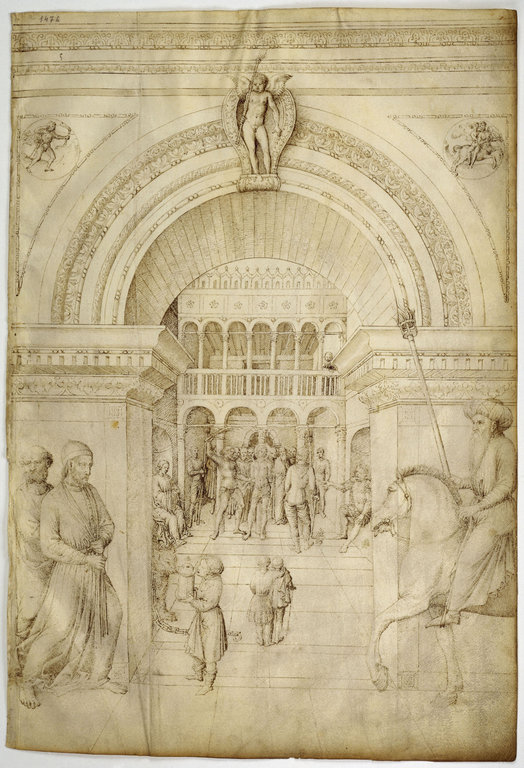
5. Jacopo Bellini, Flagellazione di Cristo, disegno a penna dall'Album di schizzi parigino, 1430-1450, fol. 8r, Paris, Musée du Louvre
5. Jacopo Bellini, Flagellation of Christ, ink drawing from the Parisian sketchbook, 1430-1450, fol. 8r, Paris, Musée du Louvre
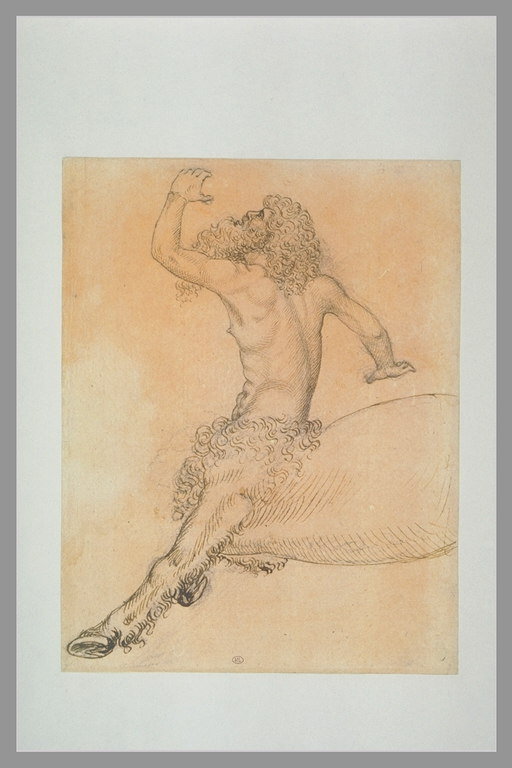
6. Pisanello (attribuzione), Centauro galoppante, disegno da sarcofago antico, 1440 ca., Paris, Musée du Louvre, Département des Artes Graphiques
6. Pisanello (awarding), Galloping Centaur, drawing of antique sarcophagus, 1440 ca., Paris, Musée du Louvre, Département des Artes Graphiques

7. Pisanello, Menadi, disegno da un bassorilievo antico su sarcofago bacchico, Oxford, University Museum
7. Pisanello, Maenads, drawing of antique bas relief on Bacchic sarcophagus , Oxford, University Museum
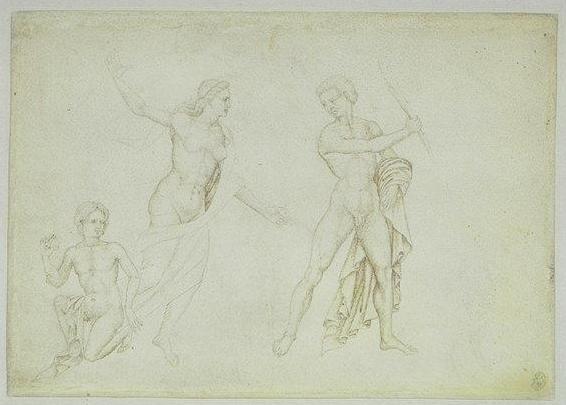
8. Pisanello (o Gentile da Fabriano), copie da pezzi antichi: figura femminile in fuga; figura inginocchiata; figura maschile che brandisce un'arma; disegno a penna, Paris, Musée du Louvre, Département des Artes Graphiques
8. Pisanello (or Gentile da Fabriano), copies from antique pieces: female figure on the run ; kneeling figure; male figure wielding a weapon; ink drawing, Paris, Musée du Louvre, Département des Artes Graphiques
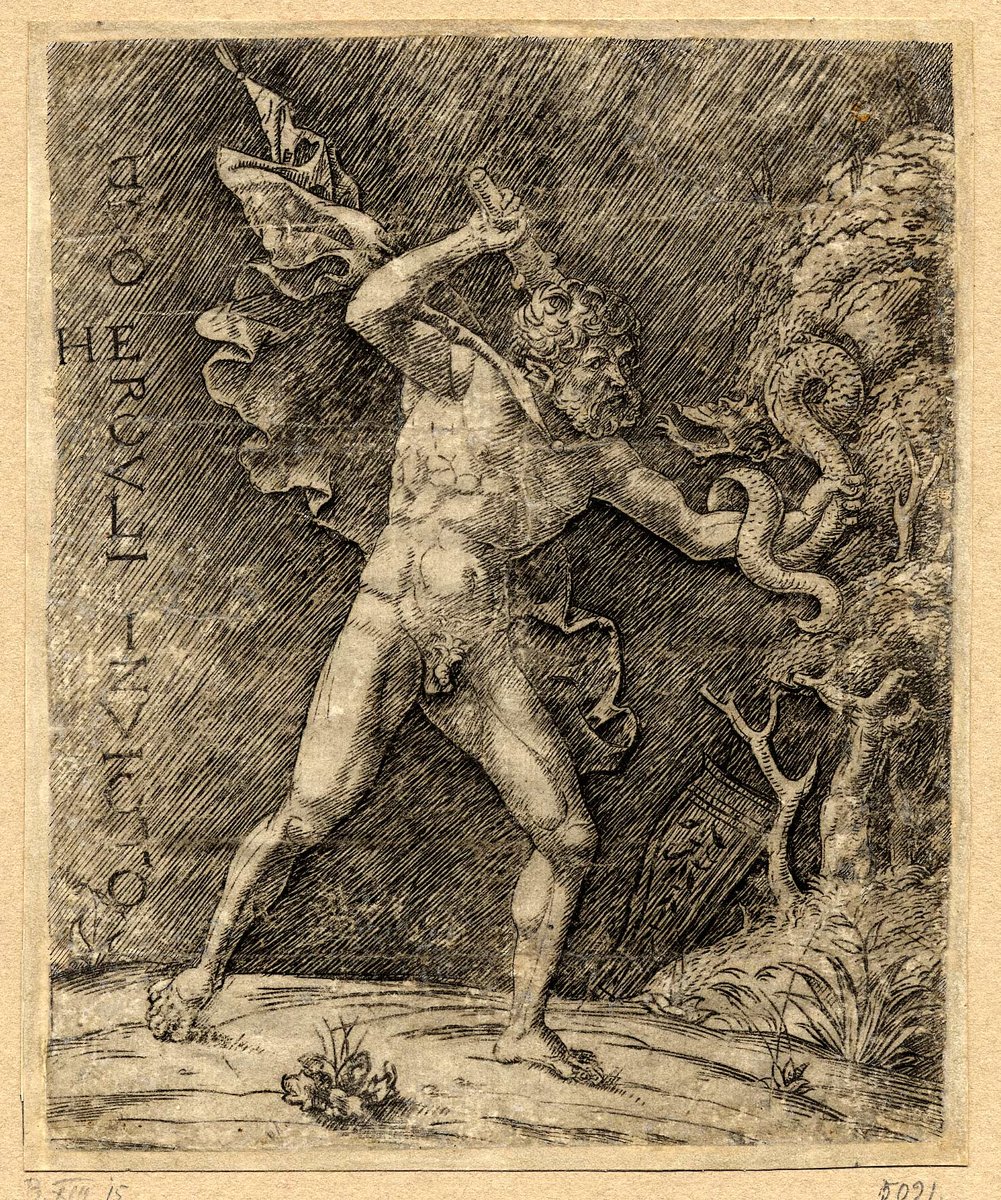
9. Andrea Mantegna (?), Ercole e l'Idra, acquaforte su rame, 1500 ca., London, The British Museum
9. Andrea Mantegna (?), Hercules and the Idra, echting on copper, 1500 ca., London, The British Museum
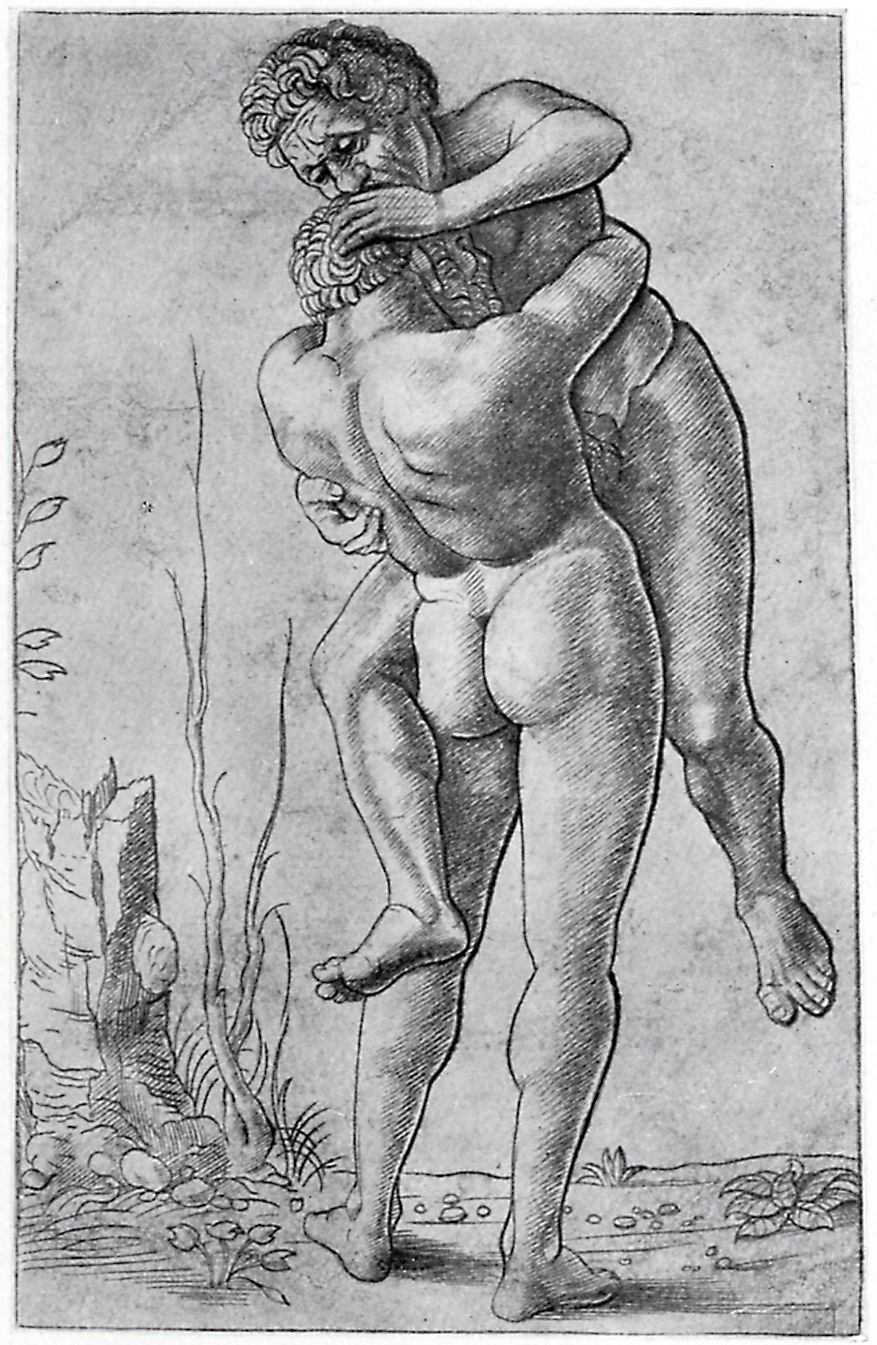
10. Andrea Mantegna, Ercole e Anteo, acquaforte su rame, 1500 ca.
10. Andrea Mantegna, Hercules and Anteos, echting on copper, 1500 ca.
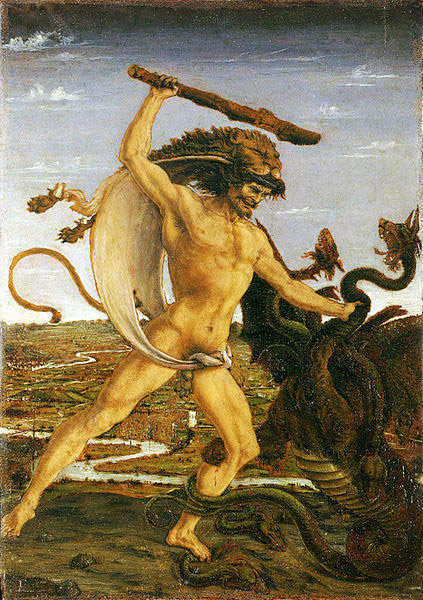
11. Antonio Pollaiuolo, Ercole e l'Idra, olio su tavola, 1460-1470, Firenze, Galleria degli Uffizi
11. Antonio Pollaiuolo, Hercules and the Idra, oil on canvas, 1460-1470, Firenze, Galleria degli Uffizi
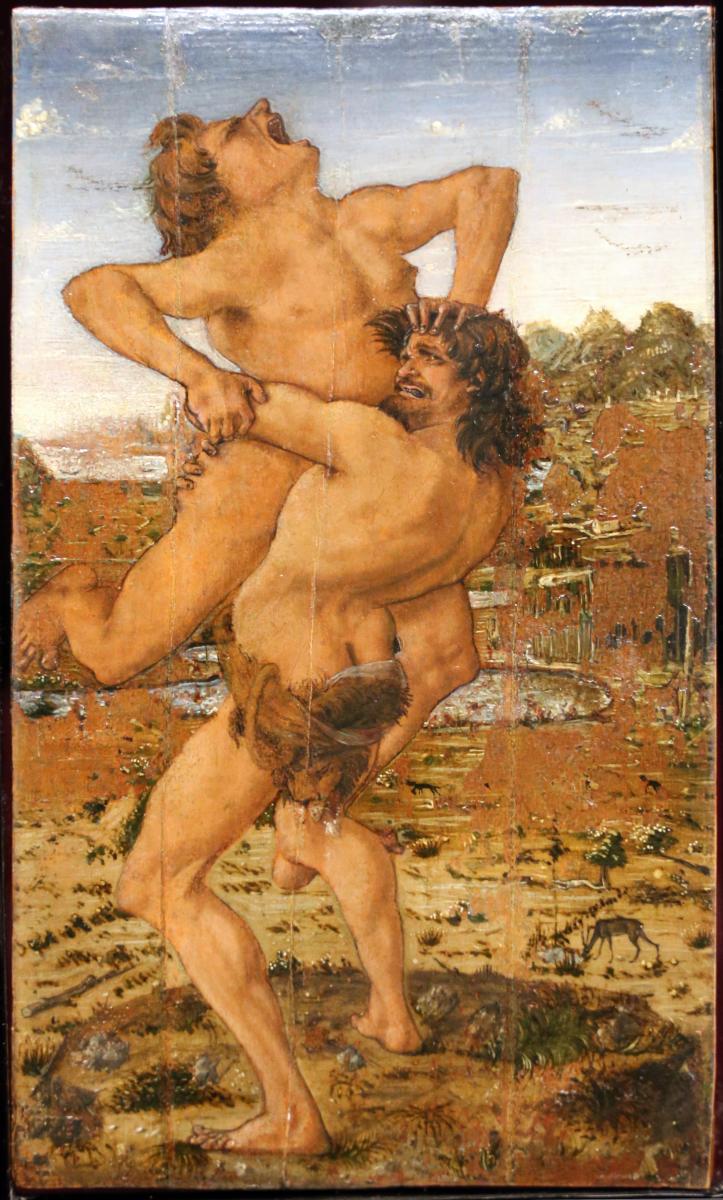
12. Antonio Pollaiuolo, Ercole e Anteo, olio su tavola, 1460-1470, Firenze, Galleria degli Uffizi
12. Antonio Pollaiuolo, Hercules and Anteos, oil on canvas, 1460-1470, Firenze, Galleria degli Uffizi
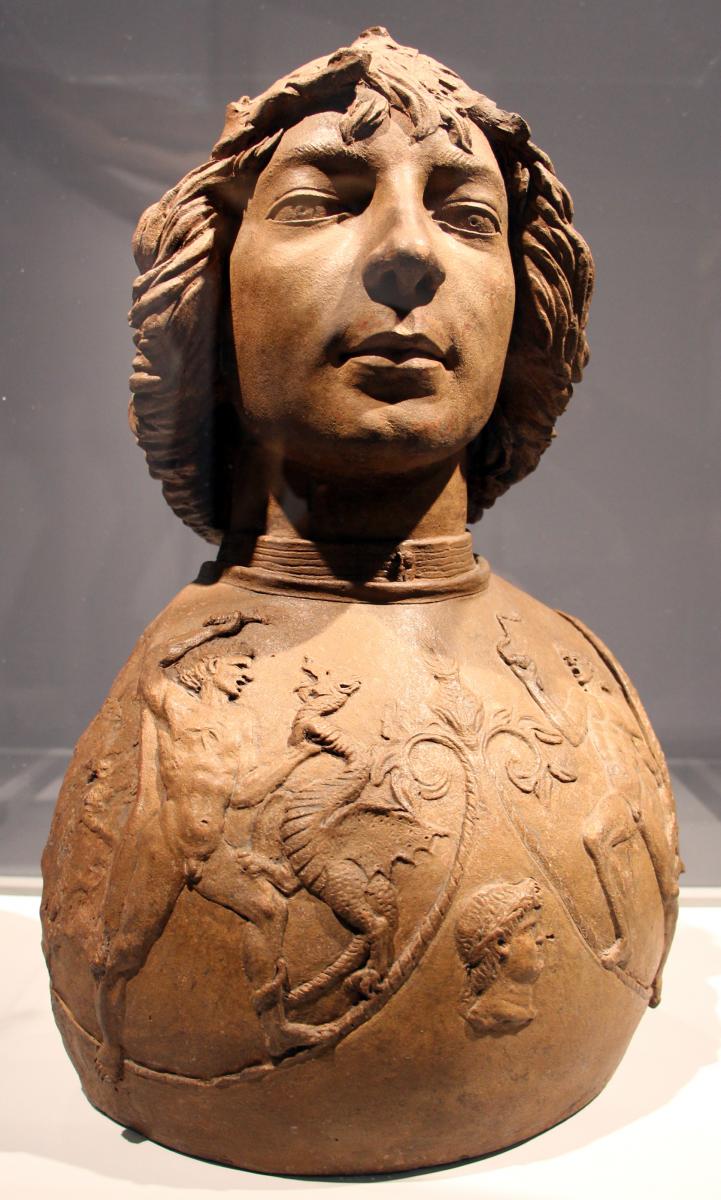
13. Antonio Pollaiuolo, Giovane guerriero con “fatiche di Ercole” sulla corazza, imitazione del bronzo in terracotta dipinta, 1475-1480 ca., Firenze, Museo Nazionale del Bargello
13. Antonio Pollaiuolo, Young warrior with “The labors of Hercules” on the armor, imitation of the copper in depicted terracotta 1475-1480 ca., Firenze, Museo Nazionale del Bargello
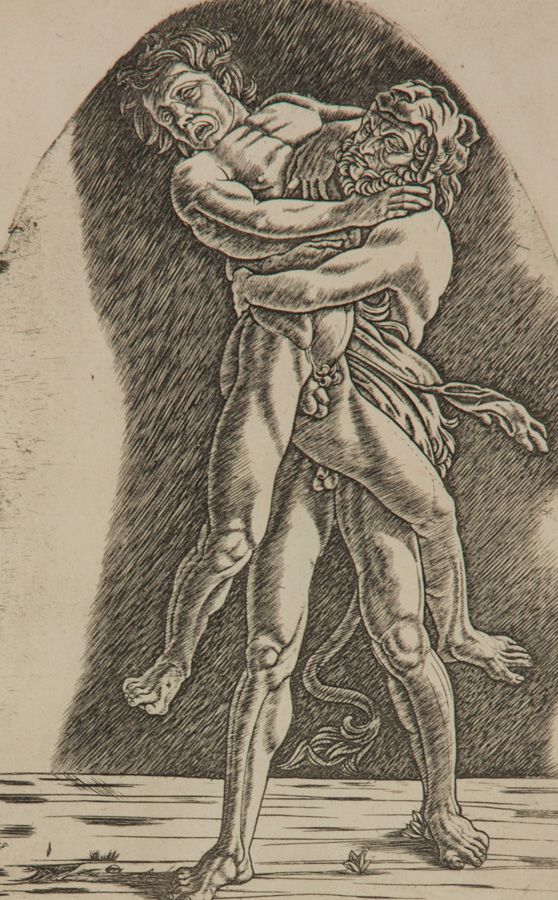
14. Scuola di Mantegna, Ercole e Anteo, acquaforte su rame, 1510 ca.
14. Scuola di Mantegna, Hercules and Anteos, echting on copper, 1510 ca.
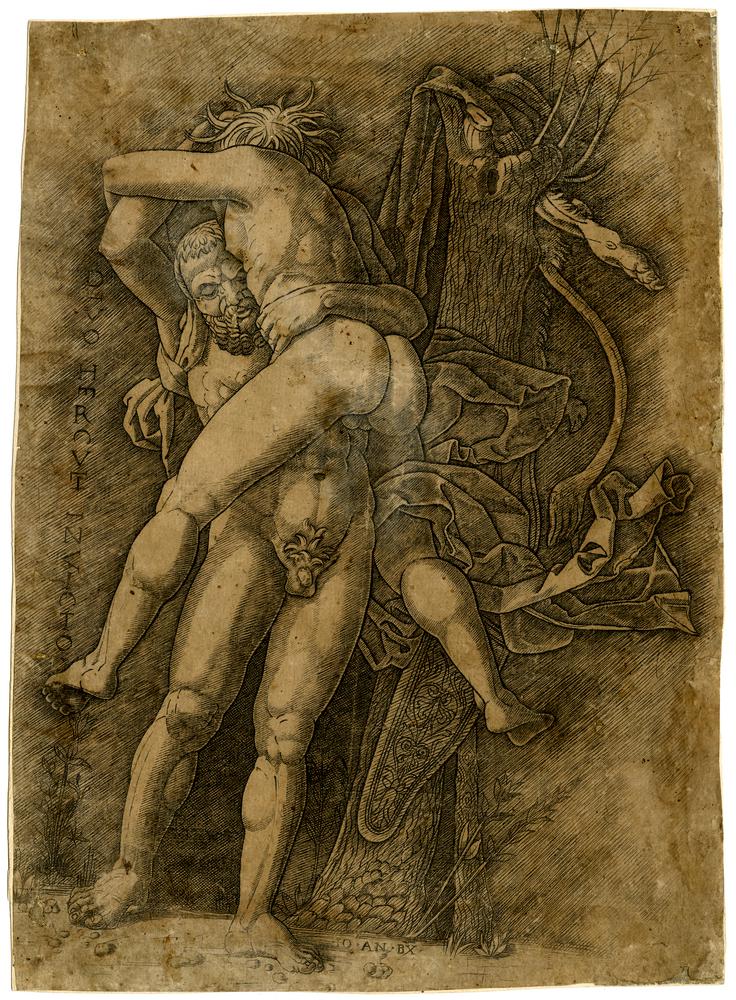
15. Giovanni Antonio da Brescia (da Mantegna), Ercole e Anteo, acquaforte su rame, 1497 ca.
15. Giovanni Antonio da Brescia (da Mantegna), Hercules and Anteos, echting on copper, 1497 ca.
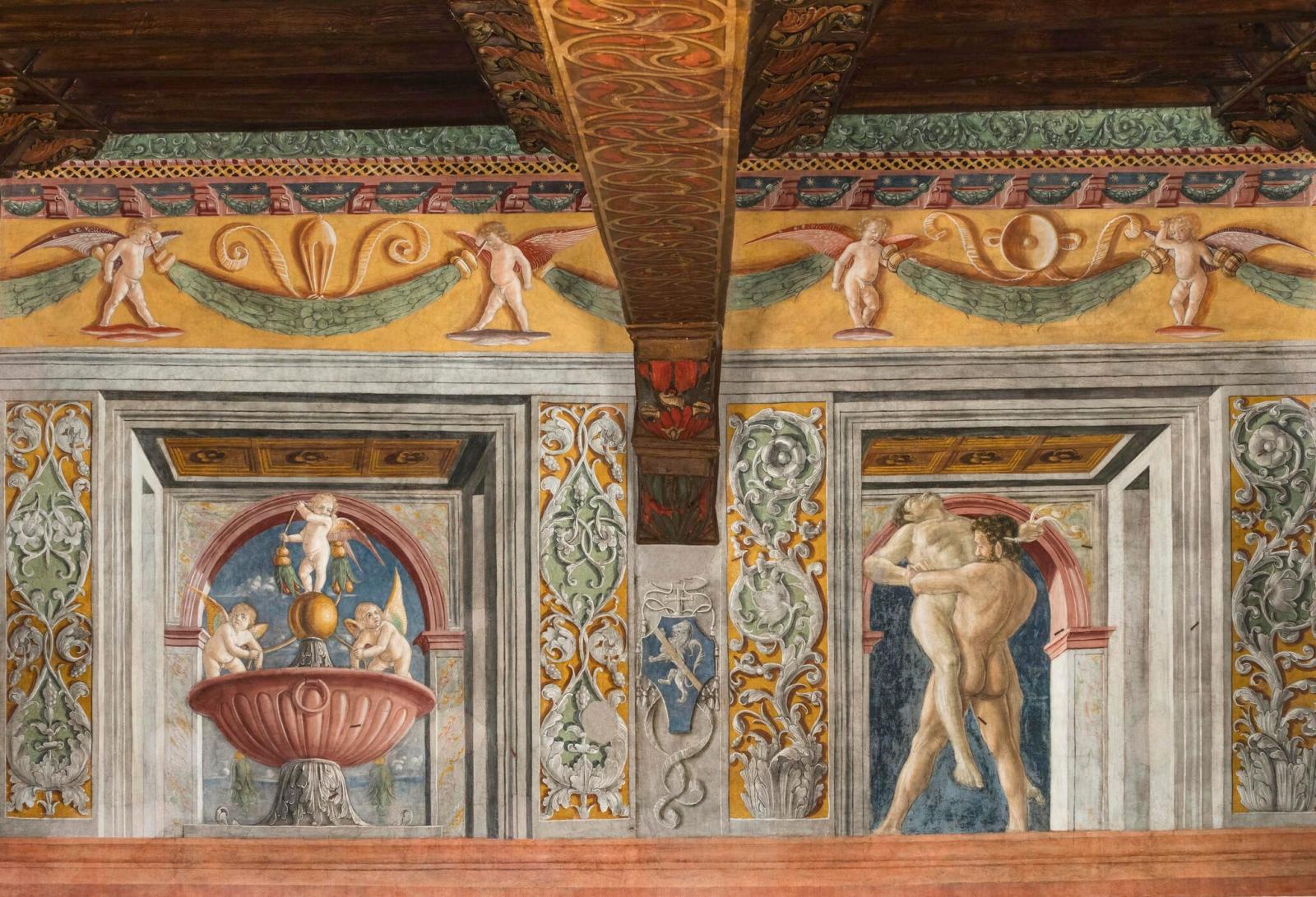
16. Antonio Pollaiuolo, Le fatiche di Ercole, affresco, seconda metà del sec. XV, Roma, Palazzo Venezia
16. Antonio Pollaiuolo, The labors of Hercules, fresco, second half of 15th Century, Roma, Palazzo Venezia
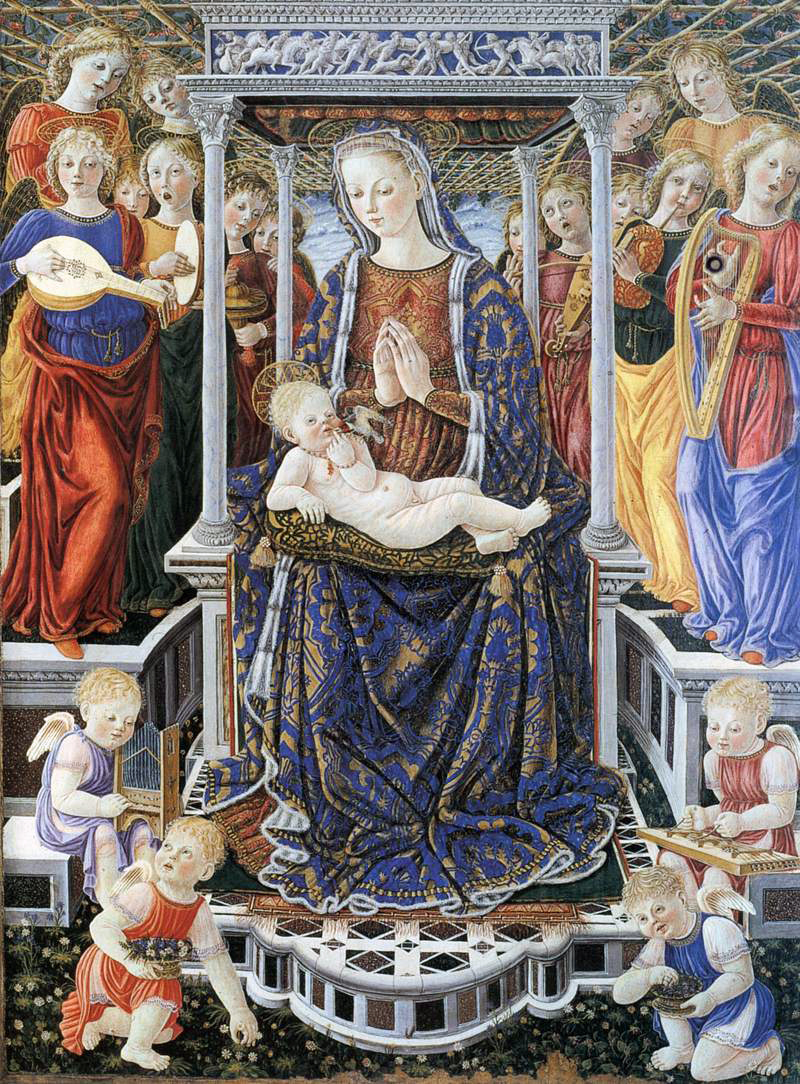
17. Giovanni Boccati, Madonna e angeli, seconda metà del sec. XV, Perugia, Galleria Nazionale dell'Umbria
17. Giovanni Boccati, Holy Mother and Angels, second half of 15th Century, Perugia, Galleria Nazionale dell'Umbria
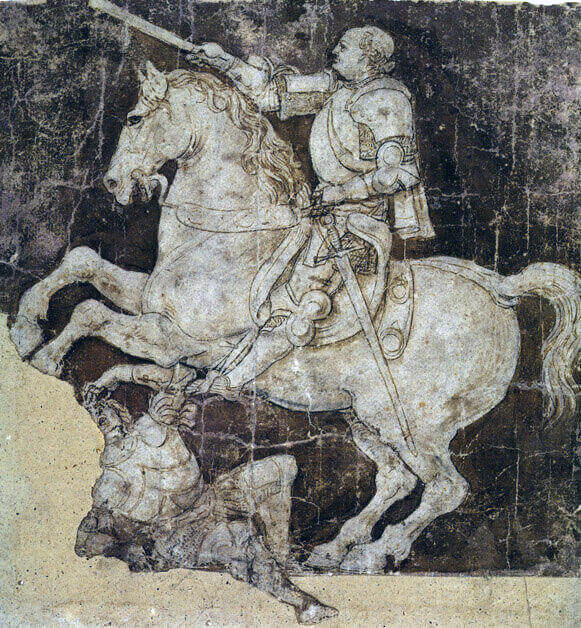
18. Antonio Pollaiuolo, Studio per un monumento equestre di Francesco Sforza, disegno a penna sfumato, 1485 ca., München, Staatliche Graphische Sammlungen
18. Antonio Pollaiuolo, Study for an equestrian monument of Francis Sforza, sfumato ink drawing, 1485 ca., Munich, Staatliche Graphische Sammlungen
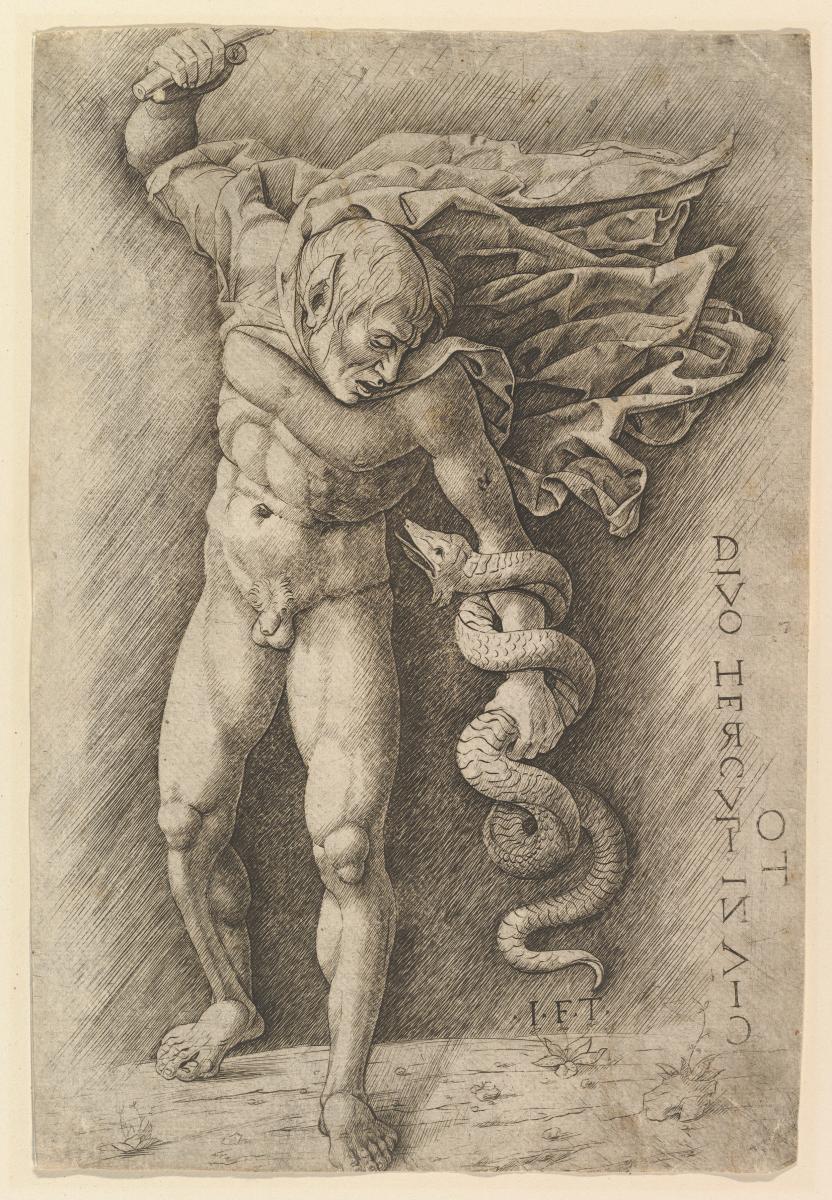
19. Andrea Mantegna, Fauno in lotta con un serpente, disegno a penna, 1480-1485, London, The British Museum, Department of Prints and Drawings
19. Andrea Mantegna, Faun in struggle with a snake, ink drawing, 1480-1485, London, The British Museum, Department of Prints and Drawings
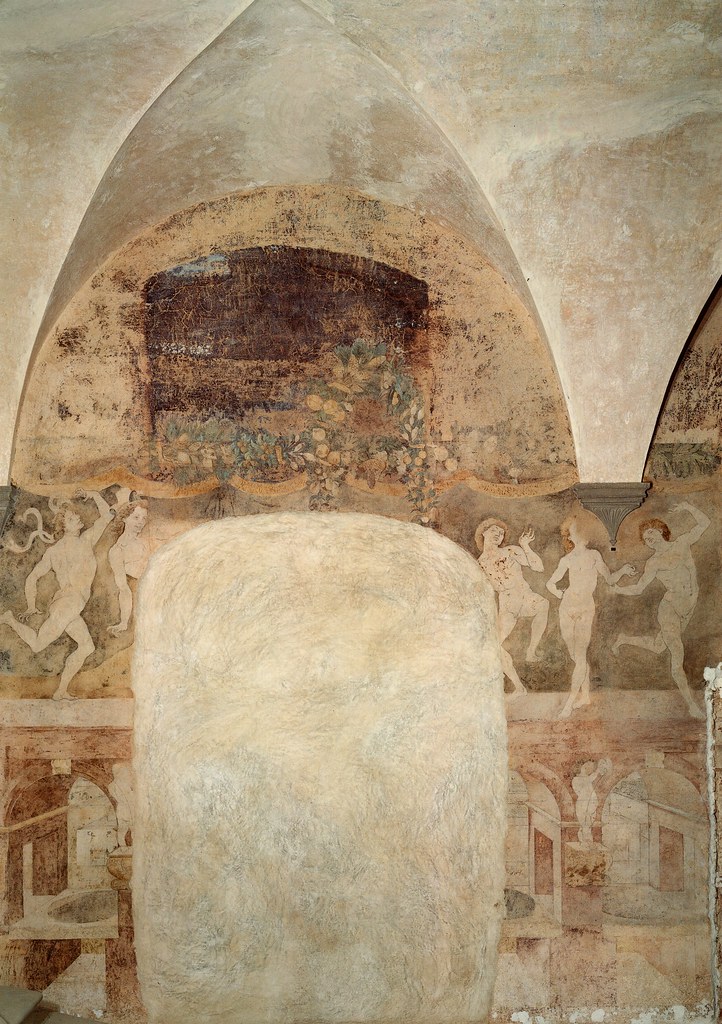
20. Antonio Pollaiuolo, Danzatori nudi, affresco, 1465-1475, Firenze, Villa Gallina
20. Antonio Pollaiuolo, Naked Dancers, fresco, 1465-1475, Firenze, Villa Gallina
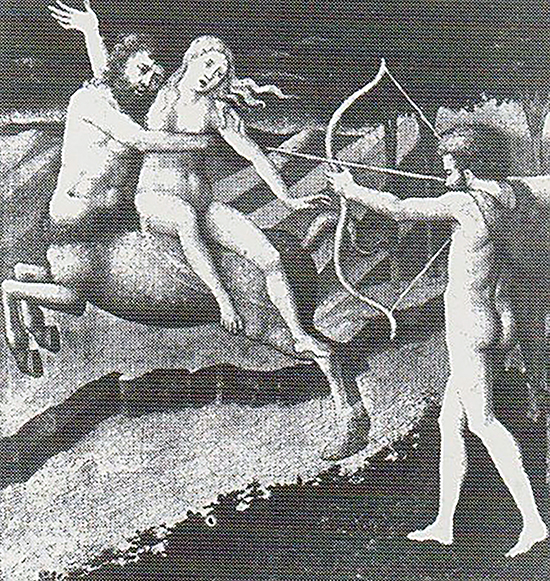
21. Jacopo Bellini (o Pisanello), Ratto di Deianira, dipinto, 1460 ca., London, Agnew Collection
21. Jacopo Bellini (o Pisanello), Deianira’s rape, painting, 1460 ca., London, Agnew Collection
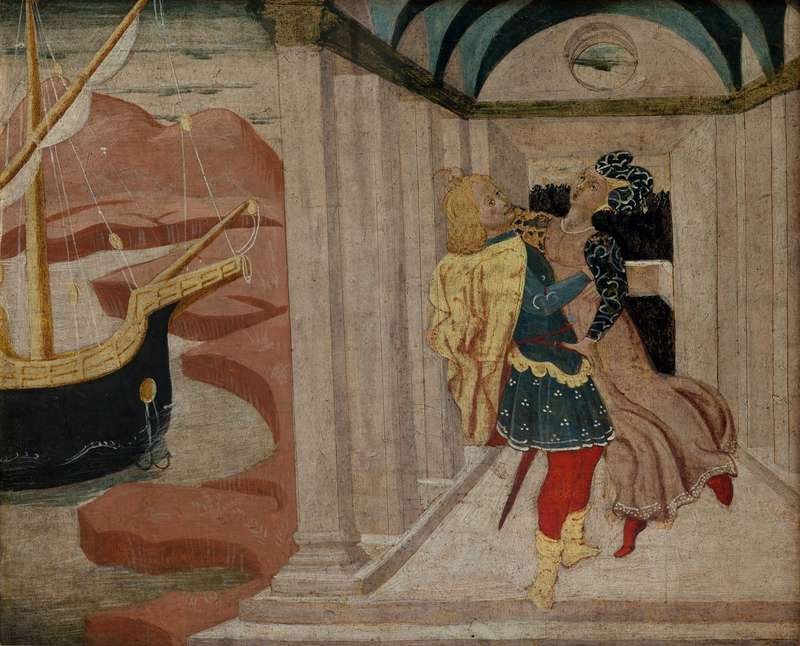
21a. Cosiddetto “Maestro del giudizio di Paride”, Ratto di Elena, cassone, 1450-70, Praha, Rudolfinum
21a. So-called “Teacher of the judgment of Paride”, Helen’s rape, chest, 1450-1470e, 1450-70, Praga, Rudolfinum

22. Giovanni Boccati, Scena di battaglia (particolare), da Madonna e angeli, seconda metà del sec. XV, Perugia, Galleria Nazionale dell'Umbria
22. Giovanni Boccati, Scene battle (detail), from Holy Mother and Angels, second half of 15th Century, Perugia, Galleria Nazionale dell'Umbria
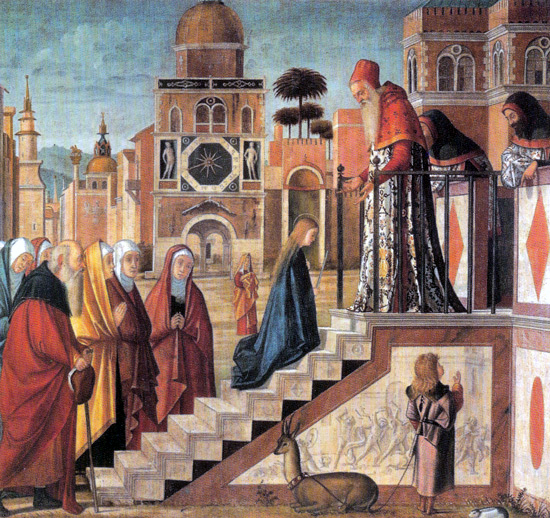
23. Vittore Carpaccio, La presentazione della Vergine al tempio, 1505-1506, Milano, Pinacoteca di Brera
23. Vittore Carpaccio, The presentation of the Virgin to the temple, 1505-1506, Milano, Pinacoteca di Brera
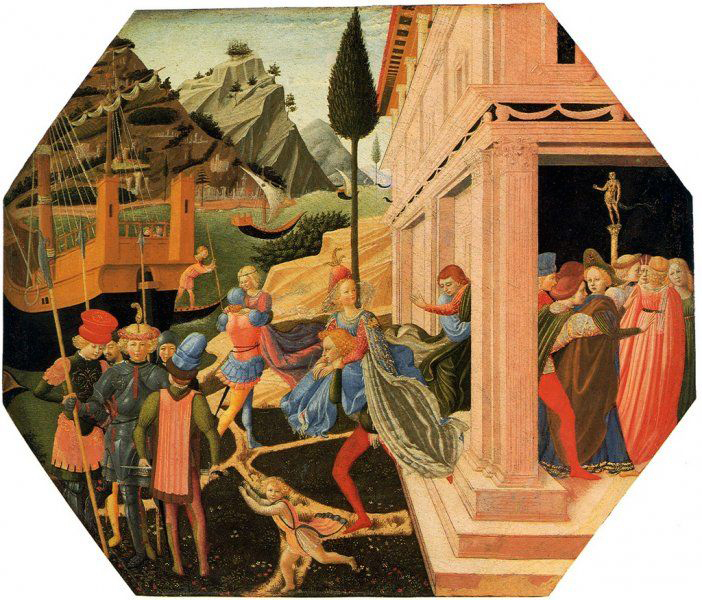
24. Scuola di Fra' Angelico (Benozzo Gozzoli?), Ratto di Elena, seconda metà del sec. XV, London, National Gallery
24. Scuola di Fra' Angelico (Benozzo Gozzoli?), Helen’s rape, second half of 15th Century, London, National Gallery
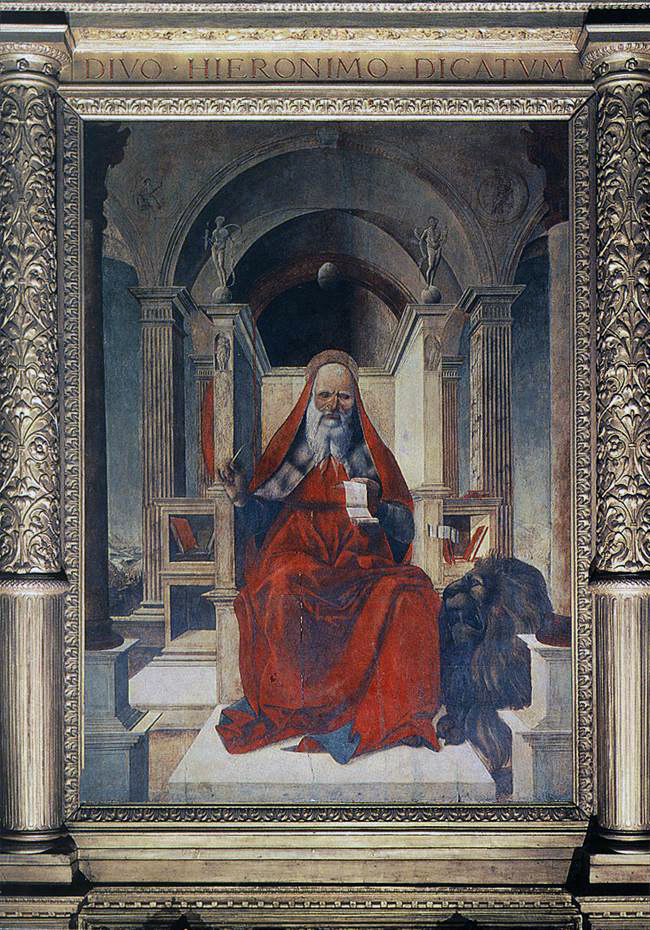
25. Lorenzo Costa, San Gerolamo, dipinto su tavola, 1485 ca., Bologna, San Petronio, Cappella de' Castelli
25. Lorenzo Costa, San Gerolamo, painted on table, 1485 ca., Bologna, San Petronio, Cappella de' Castelli
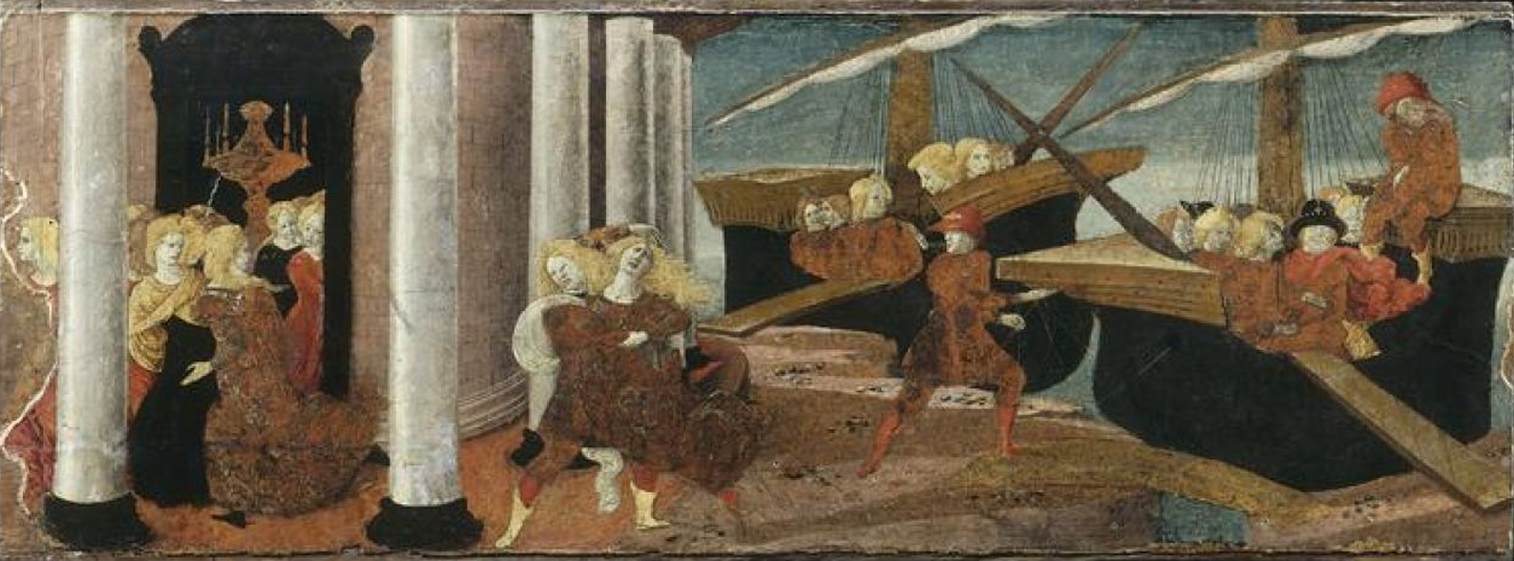
26. Liberale da Verona (attribuzione), Ratto di Elena, cassone, 1470 ca., Avignone, Musée du Petit Palais
26. Liberale da Verona (attribution), Helen’s rape, chest, 1470 ca., Avignon, Musée du Petit Palais
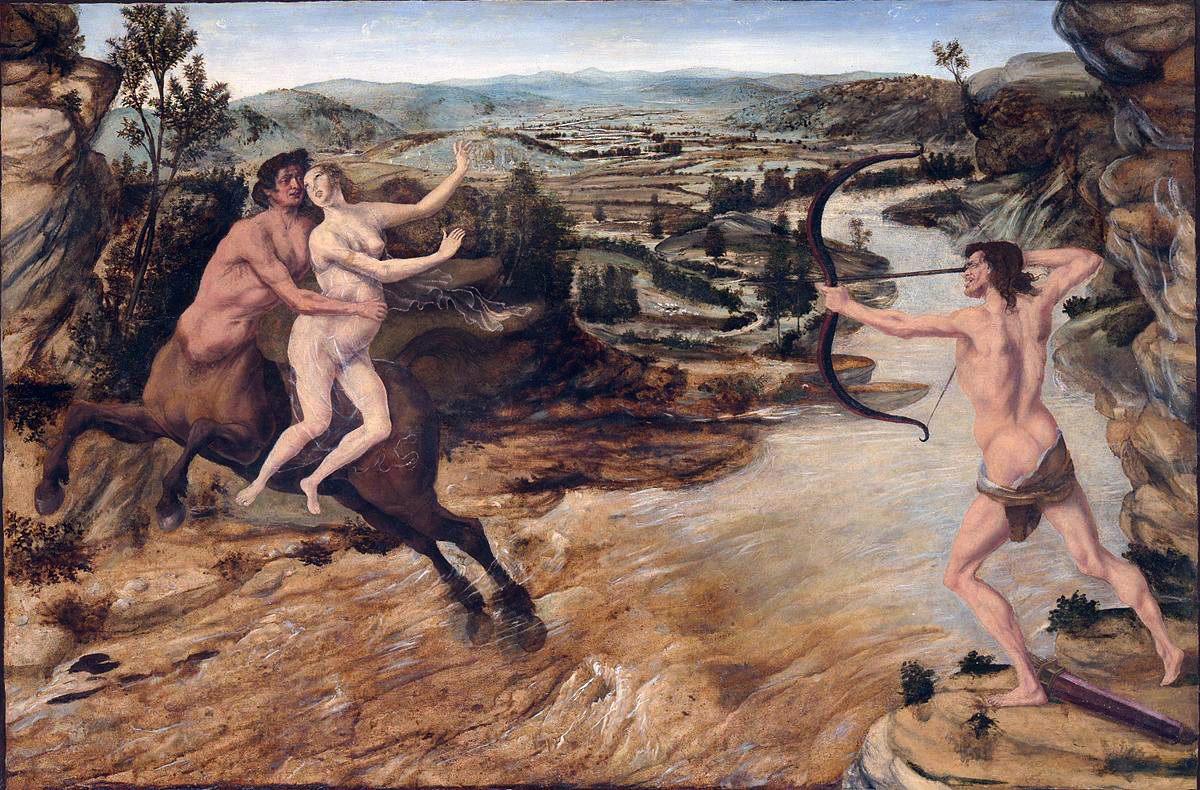
27. Antonio Pollaiuolo, Ratto di Deianira, tempera e olio su tela (riportato da una tavola), 1460-1480, New Haven (Conn.), Yale University Art Gallery
27. Antonio Pollaiuolo, Deianira’s rape, temper and oil on canvas (brought by a table), 1460-1480, New Haven (Conn.), Yale University Art Gallery
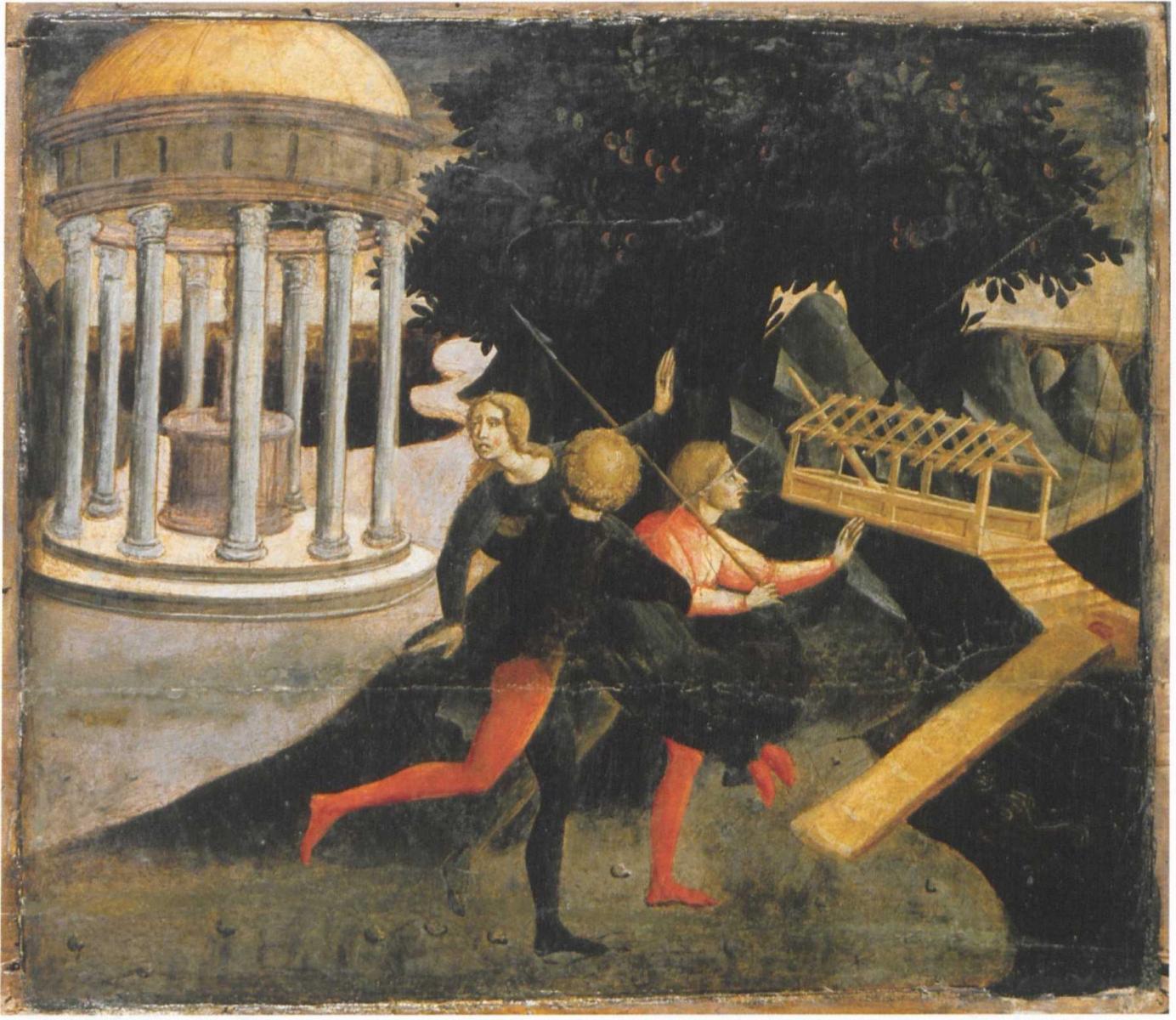
28. Cosiddetto "Maestro del giudizio di Paride", Ratto di Elena, cassone, 1450-1470, Wien, Sammlung Lanckoronski
28. So-called "Teacher of the judgment of Paride", Helen’s rape, chest, 1450-1470, Vienna, Sammlung Lanckoronski
